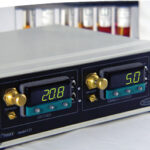NEWS ARCHIVES

Physioxia Enhances the Pro-Regenerative Activity of MSCs
Zhidkova et al. of the Russian Academy of Sciences detail the crosstalk betwen ECs and MSCs co-cultured under physiological hypoxia, and how culturing under physiologically relevant conditions increases migration and anti-inflammatory modulation.
Click here to read more (open access): https://www.mdpi.com/2673-8937/1/2/9/htm

Oxygen Levels Influence Cytokine Responses
University College Dublin’s Malkov et al. review the direct impact of cytokines on HIF signaling, and the multi-level crosstalk that shapes hypoxic inflammation.
Click here to read more (open access): https://www.mdpi.com/2073-4409/10/9/2340/htm

Nitric Oxide Mimics the Hypoxia Response to Enhance Stemness
Caballano-Infantes et al. dissect the stabilization of the HIF pathway in NO-treated iPSCs and ESCs
Click here to read more (open access): https://www.mdpi.com/2076-3921/10/9/1408/htm

Cytocentric Principles in Clinical Cancer Research: Mimicking the Hematopoietic Niche
Congratulations to Pierre-Yves Dumas et al. at the University of Bordeaux on their publication in Clinical Cancer Research, in which they used physiologic oxygen to model the tumor microenvironment in vivo.
Click here to read more: https://clincancerres.aacrjournals.org/content/early/2021/09/21/1078-0432.CCR-20-3114.long

Hypoxia As a Crucial Regulator of Muscle Vascularization
York University authors Pierre Lemieux and Olivier Birot review the relationship between sources of cellular hypoxic stress in the body, and the vascularization of muscle tissue in the presence of that stress.
Click here to read more (open access): https://www.frontiersin.org/articles/10.3389/fphys.2021.735557/full

Mechanical Loading with Physioxia Enhances Cartilage in Vitro
Lead author Alexander Szojka and colleagues at the University of Alberta investigated the effects of “mechano-hypoxia conditioning” on gene expression in engineered human meniscus tissues.
Click here to read more (open access): https://www.frontiersin.org/articles/10.3389/fbioe.2021.739438/full

O2 Regulates Pluripotent Stem Cell Niche, Metabolism, Differentiation, and Reprogramming Efficiency
Jagiellonian University authors Kinga Nit, Malgorzata Tyszka-Czochara, and Sylwia Bobis-Wozowicz offer a comprehensive review of the critical role oxygen plays in the function and metabolism of PSCs and CSCs.
Click here to read more (open access): https://www.mdpi.com/2075-4426/11/9/905

Oxygen-Controlled In Vitro Study Confirms Mechanism of Diabetic Vascular Disease
Congratulations to lead author Min Zhao and colleagues at the Southern Medical University on their publication of novel evidence linking the HIF-1a/JMJD1A signaling pathway to oxidative stress following hyperglycemia.
Click here to read more (open access): https://cmbl.biomedcentral.com/articles/10.1186/s11658-021-00283-8

Hypoxia Research Reveals Novel Diagnostic Tool for Cancer
Lead author Alicja Gluszko and colleagues discovered distinct proteomic profiles in hypoxic small extracellular vesicles, which could be used to monitor tissue hypoxia in head and neck squamous cell carcinoma.
Click here to read more (open access): https://www.mdpi.com/2072-6694/13/16/4176/htm

Same Donor Cells, Different O2: Controlling Oxygen Allows Researchers to Promote Chondrogenesis in MSC Culture
An exciting publication in Cells from Dr. Graziana Monaco et al, in which they used oxygen tension to tailor the differentiation of mesenchymal stromal cells in vitro.
Click here to read more (open access): https://www.mdpi.com/2073-4409/10/8/2165

Mitigating Neonatal Injury: Hypoxia Research Leads to New Potential Therapies
Congratulations to lead author Darren Bodkin and colleagues from SUNY Downstate Medical Center and SUNY Eye Institute on their publication in Pediatric Research, in which they demonstrated that antioxidants and fish oil may mitigate Intermittent-Hypoxia-induced injury to the gut.
Read the full paper here (open access): https://www.nature.com/articles/s41390-021-01707-z

Oxygen and HIF May Hold the Key to Improving Outcomes of Hematopoietic Disorders
Breakthrough Science: 2019 Nobel Laureate Gregg Semenza’s review of the connections between the oxygen sensing pathway and disorders of the blood.
Click here to access the review: https://ashpublications.org/blood/article-abstract/doi/10.1182/blood.2021011043/476633/Breakthrough-Science-Hypoxia-Inducible-Factors

Simulating the Bone Marrow Microenvironment In Vitro Provides Insight on Anti-Leukemic Therapies
Congratulations to first author Pierre-Yves Dumas and team at University of Bordeaux on their findings first published August 13 in Clinical Cancer Research establishing that single agent use of gilteritinib in vitro displays greater anti-leukemic activity than quizartinib, when studied in oxygen conditions which mimic the hematopoietic niche (1% O2).
Read the full paper here: (subscription required): https://clincancerres.aacrjournals.org/content/early/2021/09/21/1078-0432.CCR-20-3114

Reduce Microbial Risk in a Closed Cell Production System through Controlled Temperature and Humidity
Congratulations to senior author Alicia Henn and team at BioSpherix on their work published June 1, 2021 in BioPharm International establishing that microbial bioburden is reduced in a closed cell manufacturing system through using the physical attributes of the atmosphere rather than toxic disinfectants.
Read the full paper here: https://www.biopharminternational.com/view/temperature-and-relative-humidity-control-to-reduce-bioburden-in-a-closed-cell-processing-and-production-system-without-disinfectants





































